Camphorweed
Heterotheca subaxillaris latifolia
Aster family (Asteraceae)
Heterotheca subaxillaris latifolia
Aster family (Asteraceae)
Description:
This herbaceous plant is an annual, biennial, or short-lived perennial.
It initially forms a low rosette of petioled basal leaves up to 8"
across, but it later bolts and becomes ½–5' tall. A flowering plant is
unbranched below and branched above. The central stem and lateral stems
are erect to ascending; they are light green to dull red, terete, both
pubescent and long-hairy, and minutely glandular. Alternate leaves
occur along the entire length of each stem. These leaves are 1–3¼" long
and ½–2" across, becoming shorter and more narrow above; they are
broadly oblong, lanceolate-oblong, ovate, or deltate-ovate in shape,
while their
margins are sparsely dentate, entire (toothless), or slightly undulate.
The margins of the leaves are short-ciliate and often turned upward.
The upper and lower leaf surfaces are medium green to grayish green,
sparsely to densely pubescent, and sparsely long-hairy. The leaves are
usually sessile or they clasp their stems; some lower leaves may have
short petioles. Leaf venation is pinnate; sometimes the central vein is
unusually broad at its base. The leaves are either broadly acute at
their tips or they taper abruptly into short narrow tips. The foliage
of this plant has a camphor-like fragrance. The upper stems terminate
in either solitary, small corymbs, or small panicles of
flowerheads. Individual flowerheads span about 1¼–2¼" across when they
are fully open.
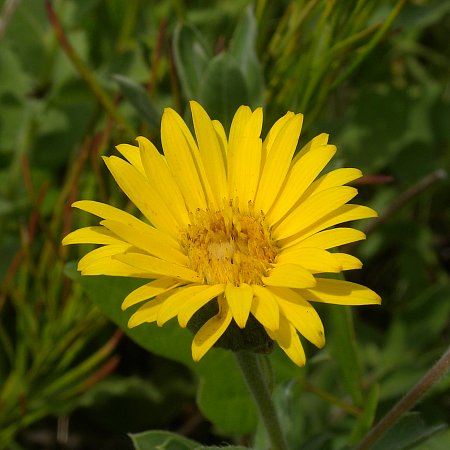
Each flowerhead has 25–60 disk florets that are surrounded by 15–45 ray florets. The corollas of the disk florets are 4–9 mm. long, yellow, and narrowly cylindrical in shape with 5 ascending lobes; they are perfect (both male & female reproductive organs). The corollas of the ray florets are 4–9 mm. long, yellow, and narrowly cylindrical in shape with petaloid rays; they are pistillate (female reproductive organs only). The petaloid rays are yellow, elliptic-oblong, and widely spreading when the flowerhead is fully open. Surrounding the base of each flowerhead, there are linear-lanceolate phyllaries (floral bracts) in several overlapping and appressed series. Individual phyllaries are medium green to grayish green, green-veined along the middle, and more or less pubescent; they often have a reddish purple dot near their tips. The peduncles of the flowerheads are ½–6" long; their tips are often discolored reddish purple to yellowish brown. The blooming period occurs from mid-summer to mid-autumn, lasting about 2 months for a colony of plants. Afterwards, fertile florets are replaced by achenes. The achenes of the disk florets are 2.5–4 mm. long, narrowly oblanceoloid in shape, slightly flattened, and pubescent; they have sessile tufts of white to light brown hairs (both long & short) at their apices. The achenes of ray florets are 2.5–4 mm. long, broadly triangular-ellipsoid in shape, and hairless or nearly so. They also lack tufts of hair at their apices. The root system consists of a taproot with secondary fibrous roots. This plant reproduces by reseeding itself. It sometimes forms colonies of plants at favorable sites.
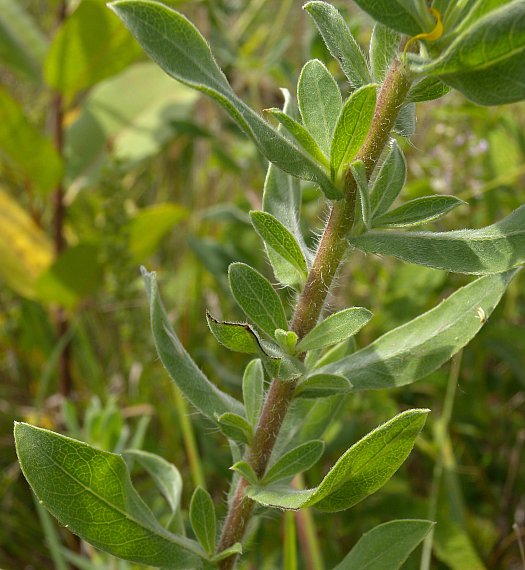
Cultivation: The preference is full sun, mesic to dry conditions, and barren ground containing either sand or gravel-clay. Individual plants are short-lived, although they can reseed themselves.
Range & Habitat: Camphorweed (Heterotheca subaxillaris latifolia) is native to sandy areas of southwestern and west-central Illinois, while in other areas of the state it is sparingly adventive (see Distribution Map). Overall, this is an uncommon wildflower in Illinois, which lies along its northern range-limit. Camphorweed is widely distributed in the southern one-half of the United States; isolated populations occur in the Midwest and northeastern United States. Habitats include sand prairies, loess hill prairies, borders of sandy agricultural fields, abandoned fields, areas along railroads, sandy and gravelly roadsides, and barren waste areas. Disturbed areas are usually preferred, although this plant also occurs in high quality sand prairies in Illinois.
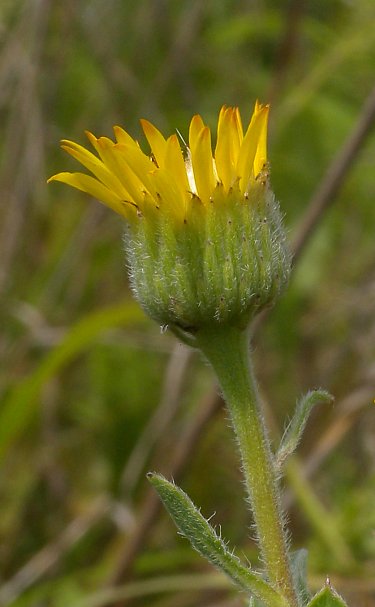
Faunal Associations: The flowerheads are cross-pollinated primarily by bees, including Halictid bees (Lasioglossum spp., Halictus spp.), plasterer bees (Colletes spp.), leaf-cutting bees (Megachile spp.), resin bees (Heriades spp.), and little carpenter bees (Ceratina spp.); see Olsen (1996) and Grundel et al. (2011). Both nectar and pollen are available as floral rewards. Some insects feed destructively on various parts of Camphorweed (Heterotheca subaxillaris latifolia) and similar species. This includes the stem-boring larvae of Melanagromyza virens and the larvae of other flies (Agromyzidae), and the flowerhead-feeding larvae of Schinia lynx (Lynx Flower Moth), Schinia saturata (Brown Flower Moth), and Cucullia alfarata (Camphorweed Cucullia); see Spencer & Steyskal (1986), Wagner (2005), and the website of the Natural History Museum (2010). The camphor-like fragrance and abundant hairs of the foliage are not attractive to mammalian herbivores and it is rarely eaten by them. The seeds are eaten by the Wild Turkey and possibly other birds (Martin et al., 1951/1961) as a minor source of food.
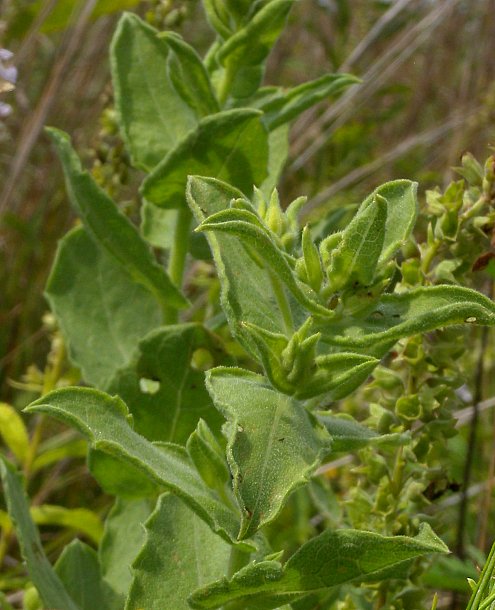
Photographic Location: A sand prairie at the Sand Prairie & Scrub Oak Nature Preserve in Mason County, Illinois.
Comments: Camphorweed (Heterotheca subaxillaris latifolia) is sometimes referred to as a distinct species, Heterotheca latifolia, but this is not accepted by the majority of botanical taxonomists. Some botanical taxonomists don't even recognize ssp. latifolia (e.g., Mohlenbrock, 2014), but the majority do. Camphorweed has a similar appearance to Prairie Golden Aster (Heterotheca camporum) and Hairy Golden Aster (Heterotheca villosa). These latter two species are native perennials that also prefer sandy habitats. Camphorweed differs from these latter two species by the distinctive achenes of its ray florets, which lack tufts of hair. The achenes of the ray florets for both Prairie Golden Aster and Hairy Golden Aster have sessile tufts of hair at their apices. Their leaves also tend to be more narrow than those Camphorweed, especially its lower leaves.
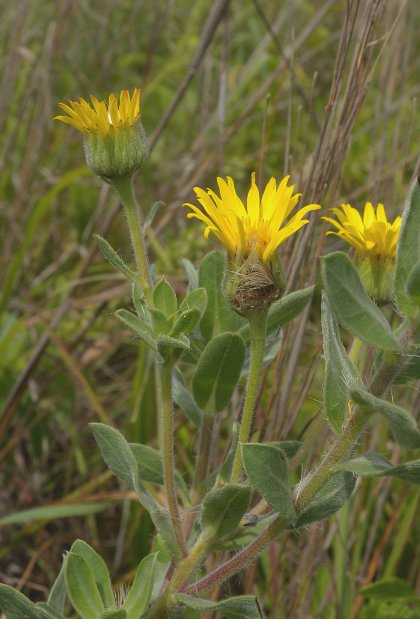
The ray floret achenes of Camphorweed overwinter in a dormant state, and usually don't germinate until the summer of the following year. In contrast, its disk floret achenes usually germinate during autumn of the same year; they do not require a winter dormancy (Baskin & Baskin, 1976). This dual strategy of seed germination probably protects local populations of this plant from extirpation as a result of variations in the local climate, especially drought. This strategy is especially important for plant species that are short-lived. Across its range, Camphorweed is rather variable in the average size of individual plants, the width and hairiness of its leaves, the length of petioles (if any) on its leaves, and the abundance of glandular secretions on its foliage. The typical subspecies of Camphorweed is found primarily in the southern United States, while ssp. latifolia is found primarily in the central and Midwestern areas of the United States, including Illinois.

Each flowerhead has 25–60 disk florets that are surrounded by 15–45 ray florets. The corollas of the disk florets are 4–9 mm. long, yellow, and narrowly cylindrical in shape with 5 ascending lobes; they are perfect (both male & female reproductive organs). The corollas of the ray florets are 4–9 mm. long, yellow, and narrowly cylindrical in shape with petaloid rays; they are pistillate (female reproductive organs only). The petaloid rays are yellow, elliptic-oblong, and widely spreading when the flowerhead is fully open. Surrounding the base of each flowerhead, there are linear-lanceolate phyllaries (floral bracts) in several overlapping and appressed series. Individual phyllaries are medium green to grayish green, green-veined along the middle, and more or less pubescent; they often have a reddish purple dot near their tips. The peduncles of the flowerheads are ½–6" long; their tips are often discolored reddish purple to yellowish brown. The blooming period occurs from mid-summer to mid-autumn, lasting about 2 months for a colony of plants. Afterwards, fertile florets are replaced by achenes. The achenes of the disk florets are 2.5–4 mm. long, narrowly oblanceoloid in shape, slightly flattened, and pubescent; they have sessile tufts of white to light brown hairs (both long & short) at their apices. The achenes of ray florets are 2.5–4 mm. long, broadly triangular-ellipsoid in shape, and hairless or nearly so. They also lack tufts of hair at their apices. The root system consists of a taproot with secondary fibrous roots. This plant reproduces by reseeding itself. It sometimes forms colonies of plants at favorable sites.

Cultivation: The preference is full sun, mesic to dry conditions, and barren ground containing either sand or gravel-clay. Individual plants are short-lived, although they can reseed themselves.
Range & Habitat: Camphorweed (Heterotheca subaxillaris latifolia) is native to sandy areas of southwestern and west-central Illinois, while in other areas of the state it is sparingly adventive (see Distribution Map). Overall, this is an uncommon wildflower in Illinois, which lies along its northern range-limit. Camphorweed is widely distributed in the southern one-half of the United States; isolated populations occur in the Midwest and northeastern United States. Habitats include sand prairies, loess hill prairies, borders of sandy agricultural fields, abandoned fields, areas along railroads, sandy and gravelly roadsides, and barren waste areas. Disturbed areas are usually preferred, although this plant also occurs in high quality sand prairies in Illinois.

Faunal Associations: The flowerheads are cross-pollinated primarily by bees, including Halictid bees (Lasioglossum spp., Halictus spp.), plasterer bees (Colletes spp.), leaf-cutting bees (Megachile spp.), resin bees (Heriades spp.), and little carpenter bees (Ceratina spp.); see Olsen (1996) and Grundel et al. (2011). Both nectar and pollen are available as floral rewards. Some insects feed destructively on various parts of Camphorweed (Heterotheca subaxillaris latifolia) and similar species. This includes the stem-boring larvae of Melanagromyza virens and the larvae of other flies (Agromyzidae), and the flowerhead-feeding larvae of Schinia lynx (Lynx Flower Moth), Schinia saturata (Brown Flower Moth), and Cucullia alfarata (Camphorweed Cucullia); see Spencer & Steyskal (1986), Wagner (2005), and the website of the Natural History Museum (2010). The camphor-like fragrance and abundant hairs of the foliage are not attractive to mammalian herbivores and it is rarely eaten by them. The seeds are eaten by the Wild Turkey and possibly other birds (Martin et al., 1951/1961) as a minor source of food.

Photographic Location: A sand prairie at the Sand Prairie & Scrub Oak Nature Preserve in Mason County, Illinois.
Comments: Camphorweed (Heterotheca subaxillaris latifolia) is sometimes referred to as a distinct species, Heterotheca latifolia, but this is not accepted by the majority of botanical taxonomists. Some botanical taxonomists don't even recognize ssp. latifolia (e.g., Mohlenbrock, 2014), but the majority do. Camphorweed has a similar appearance to Prairie Golden Aster (Heterotheca camporum) and Hairy Golden Aster (Heterotheca villosa). These latter two species are native perennials that also prefer sandy habitats. Camphorweed differs from these latter two species by the distinctive achenes of its ray florets, which lack tufts of hair. The achenes of the ray florets for both Prairie Golden Aster and Hairy Golden Aster have sessile tufts of hair at their apices. Their leaves also tend to be more narrow than those Camphorweed, especially its lower leaves.

The ray floret achenes of Camphorweed overwinter in a dormant state, and usually don't germinate until the summer of the following year. In contrast, its disk floret achenes usually germinate during autumn of the same year; they do not require a winter dormancy (Baskin & Baskin, 1976). This dual strategy of seed germination probably protects local populations of this plant from extirpation as a result of variations in the local climate, especially drought. This strategy is especially important for plant species that are short-lived. Across its range, Camphorweed is rather variable in the average size of individual plants, the width and hairiness of its leaves, the length of petioles (if any) on its leaves, and the abundance of glandular secretions on its foliage. The typical subspecies of Camphorweed is found primarily in the southern United States, while ssp. latifolia is found primarily in the central and Midwestern areas of the United States, including Illinois.